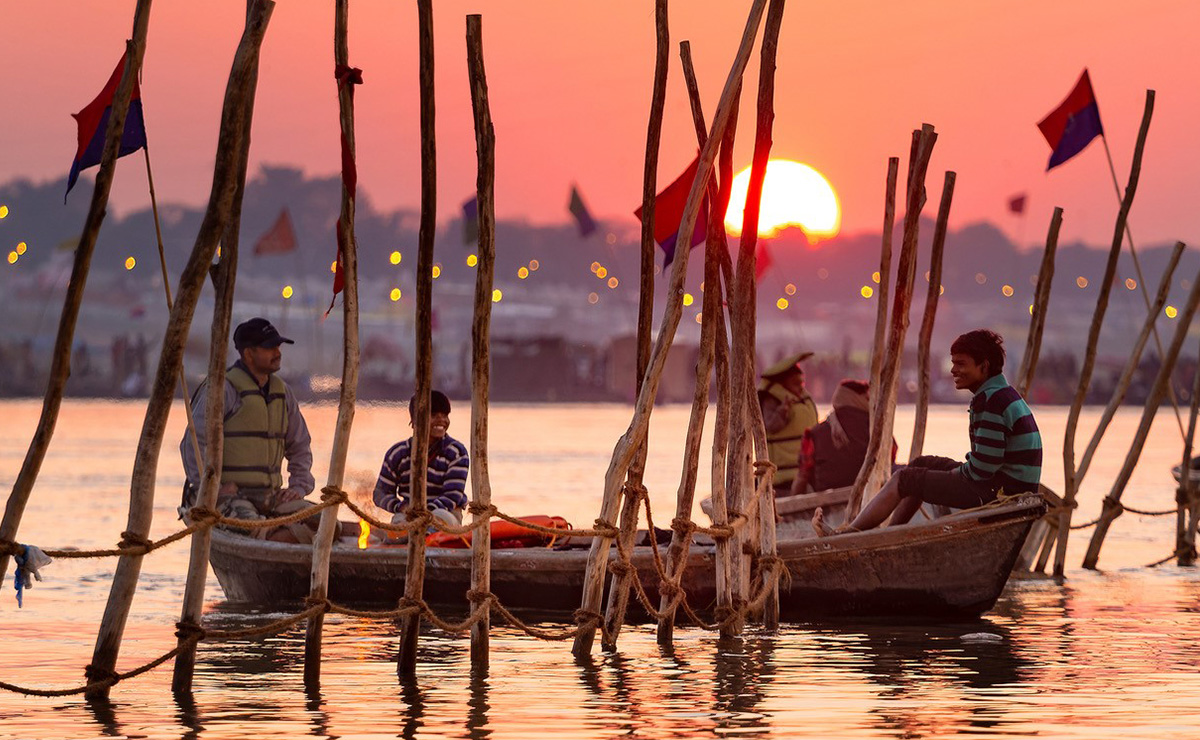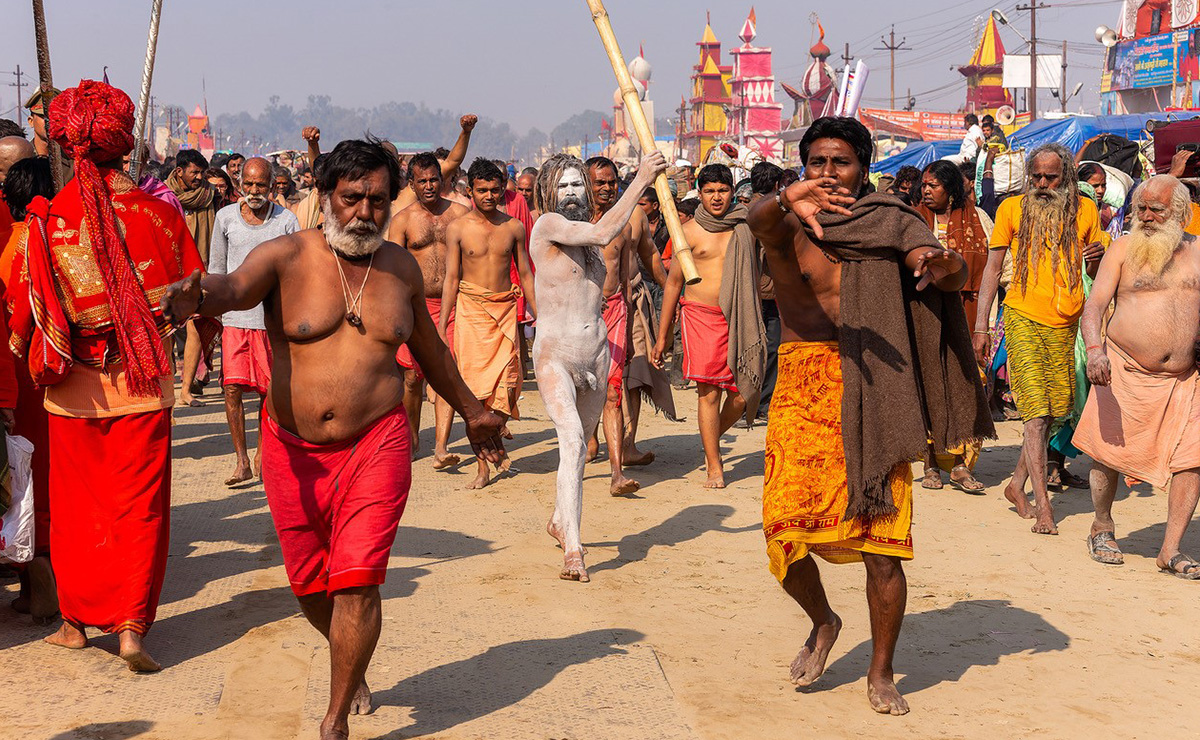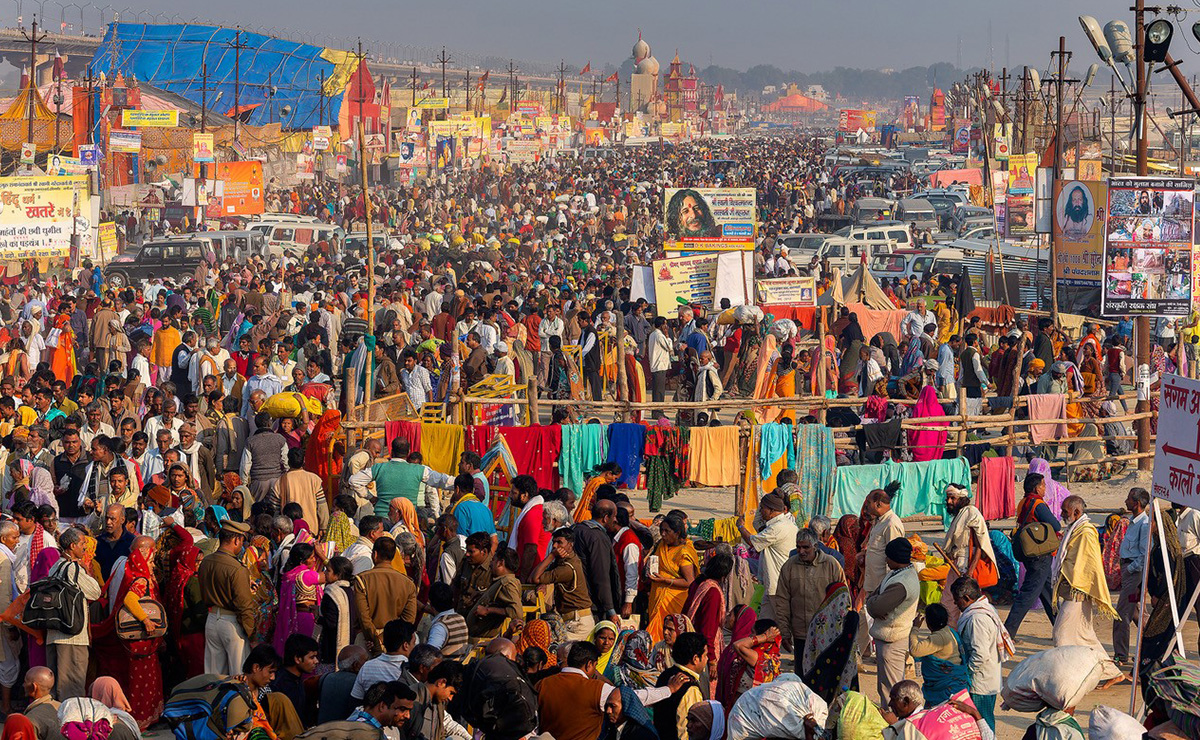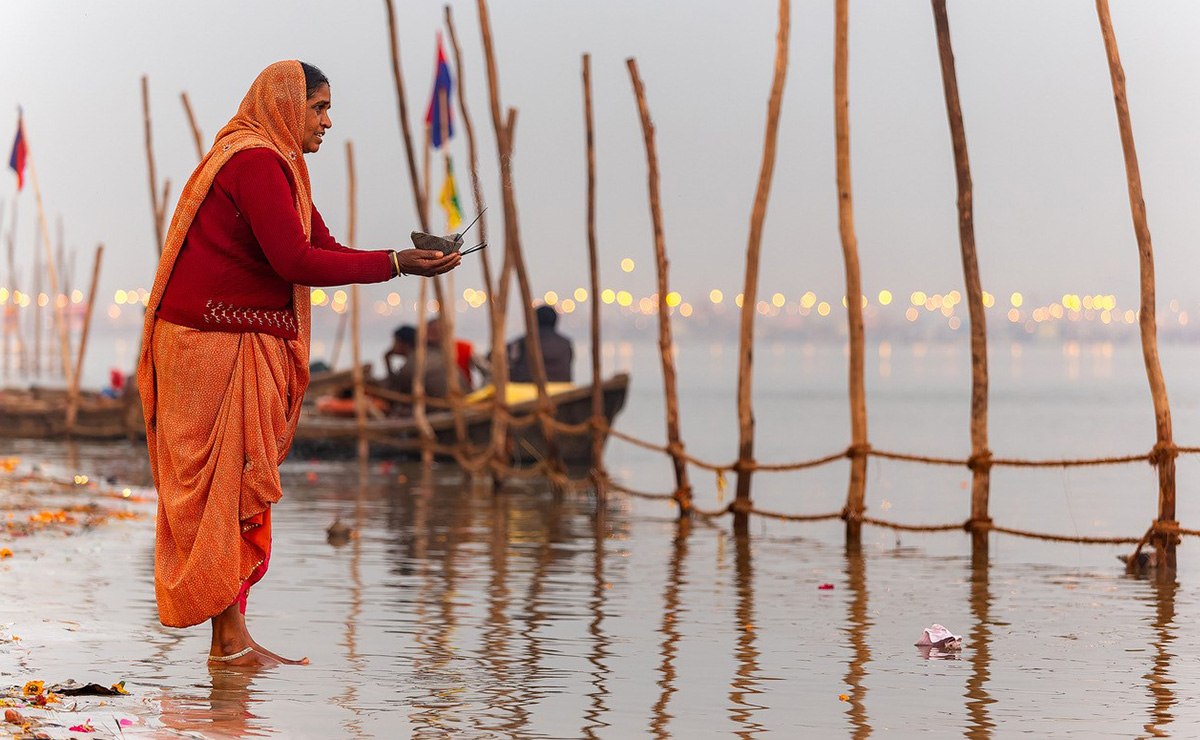WHY TRAVEL WITH US
Largest religious gathering in the world
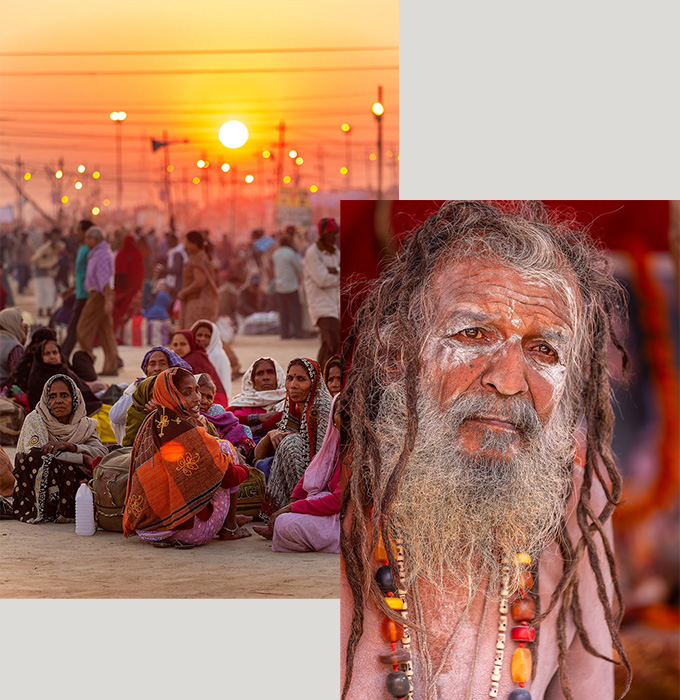
MAHA KUMBH MELA 2025
The largest religious gathering in the world for self purification!
The Maha Kumbh Mela, celebrated every twelve years in the north Indian city of Prayagraj (formerly Allahabad) is the biggest and most colourful religious gathering on Earth with millions of Hindu pilgrims expected to attend the event in January 2025. Timed according to the relative astrological positions of Jupiter, the sun and the moon, the festival is marked for many by a ritual dip in the waters at the confluence of the Ganges, Yamuna and mythical Sarasvati rivers. The devout believe that bathing in this place and at this time cleanses them from their sins.
This sensational holiday includes 3 nights and 2 full days at the Kumbh Mela at the peak of the festival. Staying at a comfortable, private fixed camp at the heart of the show provide a unique opportunity to experience one of the greatest sacred shows on ground, this will Earth.
There are sideshows, fairs, street vendors, strolling players and storytellers, sadhus and holy men, followers of a bewildering array of different Hindu deities. Naked, ash-covered Naga sadhus as well as Urdhwavahurs, Parivajakas, Shirshasins and Kalpvasis, each with their own devotional practices, will vie for your attention.
But there’s more to this holiday than the Kumbh Mela. We start out with a day of sightseeing amongst the temples and bazaars of Delhi, before taking the early Vande Bharat Express train to Varanasi, where we will attend the candle-lit aarti ceremony that takes place on the ghats beside the Ganges. We will also take a boat ride on the river following morning to observe the pilgrims as they come to bathe in the holy waters. Nearby Sarnath and the impressive Chunar Fort are also on our tick-list as we make our way to Prayagraj. Then, after our time at the Kumbh Mela, we will visit Ayodhya on the banks of Saryu River (another Hindu holy place) and spend a day at Lucknow, the City of Nawabs, sacred to people of the Muslim faith. Finally, we will visit Agra and experience both the magic of the Taj Mahal at dawn and the sheer presence of the commanding, red sandstone Agra Fort.
A holiday for those seeking complete sensory immersion into the fascinating cultural and religious experience that is northern India.
Bathing Dates
- 13th January Paush Purnima
- 14th January Makar Sankranti Phalam (1st Shahi Snan)
- 29th January Mauni Amavasya (2nd Shahi Snan)
- 2nd February Saraswati Puja on Vasant Panchami Muhurta (3rd Shahi Snan)
- 12th February Maghi Purnima
- 26th February Maha Shivratri
Highlights
- Three nights, two days at the Kumbh Mela, staying at a fixed camp on the festival site
- Experience the magical aarti ceremony on the banks of the Ganges at Varanasi
- Visit Agra’s incomparable Taj Mahal at sunrise
- Sarnath, Chunnar Fort, Ayodhya and a day of sightseeing in Lucknow
Day 01 - New Delhi
Meeting and assistance on arrival and transfer to hotel
Overnight at Hotel.
Day 02 - Tour Of Old Delhi + Sites (B) Hindu Cultural
After breakfast at the hotel, we will go out to explore the old part of Delhi. We will visit the great Jama Masjid, the principal mosque of Old Delhi. Built in the year 1656 AD by the Mughal Emperor Shah Jahan, it is the largest and best-known mosque in India. The courtyard of the mosque can hold up to twenty five thousand worshippers. We can then take an exciting rickshaw ride through the nearby colourful old bazaar of Chandni Chowk and see (but not visit) the Red Fort, which has the same Mughal architecture and structure as Agra Fort (which we will visit later in the tour). Also on our list today is the Hindu Temple Complex of Akshardham, built on the banks of the Yamuna River and boasting 234 ornate pillars, 20,000 statues and numerous arches. We spend a second night at our central hotel.
Overnight at Hotel.
Day 03 - Early train to Varanasi and evening aarti ceremony on the Ganges (B)
We have an early wake up and breakfast before going to the nearby New Delhi Railway Station to catch the 0600 train to Vara asi. This is the new Vande Bharat express train service and forthe eight hours of the journey we will be treated to the best of the Indian railway experience as we watch the fascinating kaleidoscope of the Indian landscape. Arriving in Varanasi in the early afternoon, we will transfer to our hotel in the city and have time for lunch before taking a motorised rickshaw (tuk-tuk) ride to the banks of the Ganges. Here, we will have a short guided tour of alleyways and temples and have some time to take in the atmosphere of this spiritual place before boarding a boat which provide the best view point for the aarti ceremony. Taking place on the wide stone steps known as ghats, where pilgrims take the waters and perform their puja , the aarti ceremony involves seven priests who carry butter lamps and chant and sing in praise of Mother Ganga. As a part of the ceremony, thousands of small floating butter lamps are prepared, each one representing the hopes and prayers of the individuals who push them out into the gentle current. We return to our hotel by tuk-tuk.
Overnight at Hotel.
Day 04 - Varanasi Sunrise sail on the Ganges, Bharat Kala Bhavan Museum and Sarnath visit (B)
Leaving the hotel in the early morning pre-dawn darkness we make our way by bus through the quiet city streets back to the ghats where our boat is waiting. Afloat on the river we can enjoy the sun rise over the Ganges and the ghats. We are rowed slowly along the river, watching the activity of the ghats as the devotees come down to the waters; all aspects of life are on displayas people make their offering and prayers, wash themselves and their clothes and even cremate their loved ones on the banks of the most important river in Hindus. Returning to our hotel we have free time to rest or to shop for souvenirs including silk goods for which Varanasi is famous. In the late morning, we will visit the museum of Bharat Kala Bhavan which houses a vast collection of paintings, Hindu and Buddhist sculptures and other materials of archeological importance. After lunch we will visit the Buddhist site of Sarnath with its impressive stone stupa, temples and museums.
Overnight at Hotel.
Day 05 - Drive via Chunar Fort to Prayagraj about 16o kms/qbout 5 hrs). Comfortable fixed camp at the heart of the Mela ( B, L, D)
It is a drive of around five hours today to the site of the 2025 Kumbh Mela at Prayagraj (previously known as Allahabad) but we will break the journey to pay a visit to the very impressive Chunar Fort which rises above the Ganges just about half an hour south of Varanasi. Built of local red sandstone and rebuilt several times, the fort has a long and fascinating history; supposedly established by Vikramaditya of Ujjah (56 BC) and successively occupied by prominent historical figures inluding Sher Shah Suri, the Emperor Akbar, Aurangzeb, the Nawabs of Avadh and, in 1764 the British Raj. After our visit to the fort, we continue our journey westwards to Prayagraj where we check in at our comfortable, private fixed camp accommodation at the heart of the Kumbh Mela site.
Overnight at Camp.
Day 06 - Prayagraj - at the Kumbh Mela (B, L, D)
Now properly called Prayagraj, this city has been the site of religious fairs for centuries and these have taken place annually at Triveni Sangam at the confluence of the Yamuna and Ganges rivers. A third mythical river, the Saraswati, joins the other two rivers at this point. Since the 19th Century, this site has been one of the four venues of the Kumbh Mela. The full (Maha) Kumbh Mela takes place on a 12-year cycle and the last time this took place at Prayagraj in 2013 some 30 million people attended; the largest peaceful gathering in the world. The festival is marked by a ritual dip in the Ganges on several auspicious days, determined according to the Hindu lunar-solar calendar. The festival is also a celebration of community and commerce with markets and preachings, charitable food handouts and spectacularly colourful entertainment. Options to explore with our guide include the Hanuman Temple, Akshya Vat and Allahabad Fort. We will spend the day at the festival with lunch and dinner at the camp.
Overnight at Camp.
Day 07 - Prayagraj - at the Kumbh Mela - Makar Sankranti. (B,L, D)
After breakfast at the camp, we will head out again to experience the Mela. Today is the first of the 'royal bathing' days, known as Makar Sankranti and, if you are aiming to take a holy dip at Triveni Sangam, today is the day to do it. Hindu mythology suggests that water of the Ganges turns to nectar on this day and a ritual bathing will take away all sins. We will also visit the camps of some of the usually fourteen separate 'Akharas' the groups of sadhus and other religious persons, followers of different Hindu deities; Shiva, Vishnu, Brahma and others). We spend a third night at our fixed camp accommodation.
Overnight at Camp.
Day 08 - Drive to Ayodhya about 175 kms/qbout 4 hrs, the birthplace of Prince Rama. Afternoon sightseeing (B)
After breakfast we will say goodbye to the River Ganges and head north across country to Ayodhya, a drive of around four hours. Situated on the banks of Sarayu River, Ayodhya is oneof the most sacred places for Hindus and was called Saket in ancient times. This place is mentioned in several legends and stories including the 24,000 verse Sanskrit epic, the Ramayana. We will have a sightseeing tour after lunch in Ayodhya and visit the newly built Ram Janmabhoomi Temple. According to the Ramayana, Prince Rama, an incarnation of Lord Vishnu, grew up beside the Sarayu River. We will also visit the 10th Century Hanumn Garhi Temple, dedicated to the 'monkey god' Hanuman.
Overnight at Hotel.
Day 09 - Drive to Lucknow about 140 kms/about 3 hrs and aftern on at leisure. Optional sightseeing tour (B)
After breakfast we will have a three-hour drive to Lucknow, the capital of Uttar Pradesh and a place often referred to as the 'City of Nawabs'. Lucknow is one of the most pristine and multicultural cities of India and flourished during the 18th and the 19th centuies as an artistic and cultural centre under the reign of the Nawabs of Awadh. Arriving in the city at lunchtime, we will check in at the excellent group hotel and the remainder of the day is at leisure. The city does have various architectural and historical highlights and for those who are keen to explore a short sightseeing tour on foot can be arranged.
Overnight at Hotel.
Day 10 - A day for sightseeing i City of Nawabs ( B)
Lucknow is known for its Nawabi heritage and outstanding architecture, but Lucknow, is also a total foodie's paradise. From royal relishes to kebabs, paans and biryanis, you never know what culinary gems you'll find tucked within Lucknow's narrow alleyways. Our full day tour will include visits to several of the city's impressive 'imambaras' which are places of Muslim worship built by the Nawabs in the 18th and 19th Centuries. Muslim people from all over the region come to the imambaras each year to celebrate the religious festival of Muharram. Tombs and temples, domed and gilded in silver and gold, with ornate interiors featuring floral designs and chandeliers are all part of today's richness. We will also see The Residency, home to officials of the British Raj at the start of the 19th century, the imposing gateway of Rumi arwaza, the villaand garden of Sikandar Bagh and the stately gardens and monument of Ambedkar Park.
Overnight at Hotel.
Day 11 - Drive from Lucknow to hrs (B) Agra about 5
Today enjoy a leisurely breakfast at the hotel, before 5 -hour drive westwards to Agra. Arriving in Agra we check in at time. The earliest reference to Agra can be found in the epic Mahabharata where it is referred to as the Agravana. It was in the medieval period, however, that Agra rose to prominence as the capital of the Mughals when the city was beautified with gardens, water falls, bathhouses and canals. Today, the bustling streets of Agra boasts a thriving carpet industry, leather worker and of course marble and sandstone sculptors, some of who claim to be descendants of the craftsmen who helped build the great Taj Mahal.
Overnight at Hotel.
Day 12 - Visit the Taj Mahal at explore Agra Fort. Late afternoon sunrise, then train to Delhi. ( B)
Yet another highlight of the tour, this morning at sunrise, we visit the Taj Mahal - one of the man-made 'seven wonders' of the world which took 20,000 people 22 years to build. Its dazzling white walls and dome are inlaid with 28 different types of precious and semi-precious stones, some of which pick out verses from the Koran in highly decorative script. The Taj Mahal itself is a mausoleum for Mumtaz the wife of its builder Shah Jahan and is set in tranquil gardens. After our visit, we return to our hotel for a late breakfast and a wash and brush up, before heading out to see the Agra Fort, another UNESCO World Heritage Site. Commanding gates, fashioned in red stone, as well as an excellent view of the Taj Mahal, just two and a half kilometres away, are highlights of this impressive site. We will return to Delhi on the late afternoon Gatiman Express train and spend short night near airport.
Late night transfer to the airport to catch an international flight back home.
Day 13 - Early morning departure

